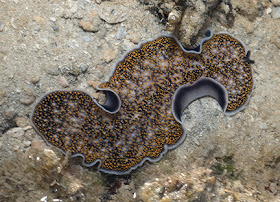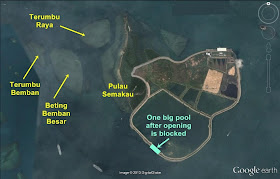We didn't see any coral bleaching, although the shore was a little quiet. The seagrasses don't seem to be doing well.
I surveyed mainly the coral rubble and reef edge today. What a nice surprise to see a little Fluted giant clam! We have recently been losing known giant clams to death and possible poaching. I hope this one stays safe!
Although the rubbly area at first appears lifeless, there are many animals here that are well camouflaged. Like this small Reef octopus which I only spotted because it moved and then changed colours so its arms were pale. The webbing between its arms forms a net which it uses to trap any small prey that may attempt to escape as it forages among the rubble.
Can you spot the Durian sea cucumber? These are quite common on Pulau Semakau.
There was this little fish on a coral which disappeared after I took the shot.
The Blue spotted fantail ray may also be hidden under sand. So we must walk carefully. Pei Yan saw a shark!
This is not rubble. It is not one but TWO nudibranchs: Dendrodoris tuberculosa. They look like they are about to mate as they are aligned head-to-butt, side-by-side. Nudibranchs are hermaprodites and each nudi has both male and female organs. When two nudis meet, they exchange sperm.
This not a dead leaf. It is a nudibranch. The Discodoris boholiensis which seemed to be in season today. Other creatures seen on the coral rubble area included some Frilly sea anemones.
Hurray, the flatworms are back. I finally saw the large Spotted black flatworms which are usually common on our reefs, but which we couldn't find during the last few trips when we were specifically looking for flatworms.
I also check for coral bleaching during our survey. What is coral bleaching and why this is of concern on the Bleach Watch Singapore blog. Fortunately, the latest Bleaching Alert Areas from the NOAA website shows that Singapore now falls outside the 'Watch' status. Today, I didn't see any outright bleaching. Let's hope our corals have passed the danger period for the year.

There were many Pore corals and most of them were dark brown, or a pale brown. Some of the Favid corals were yellowish or pale but not bleaching.
I saw two Flowery disk corals and they were both very pale. But the other Disk corals I saw seemed alright.
I saw a few Cauliflower corals. All of them were not bleaching but most had dead portions. I saw many small to large Crinkled sandpaper corals and they were all nice and brown.
I saw several small Acropora coral colonies and they were all not bleaching. These branching corals are home to all kinds of tiny creatures such as Coral scallops.
In one Acropora coral, I found a Bandit coral crab, fiendishly hard to photograph.
At Marine at Keppel Bay, the corals growing on the pontoon are doing well and not bleaching.
There were only a few small Leathery soft corals and they were all not bleaching. I only saw one Asparagus flowery soft coral and it was alright.
There were many scattered clumps of colourful sponges of all kinds.
Sadly, most of the Tape seagrasses I saw were cropped very short.
There were also patches of other seagrasses with burnt and cropped tips.
There is still a variety of seagrasses on the shore, but they are almost all of them heavily coated in ephiphytes. There were also many Upsidedown jellyfishes, Common sea stars and Garlic bread sea cucumbers in the sandy and seagrassy areas. Other interesting finds for the day was a small Masked burrowing crab by Mei Lin.
This lovely Fire anemone was found in a pool among the seagrasses. We looked but couldn't find any animals living in it. Jianlin, however, saw one eating a fish! There were also many Haddon's carpet anemones and Giant carpet anemones. I saw one anemone shrimp but no clown anemonefishes. We saw many clown anemonefishes during our last trip here in Aug 2014.
There is a large mangrove area next to this shore, which I didn't get to check out. But some of the team did and saw Dog-faced water snakes.
Very close to the Pulau Semakau Southern shore that we surveyed today is a fish farm which is said to be the largest fish farm in Singapore.
We have noticed many disturbing impacts of this fish farm on the natural shores of Pulau Semakau, see the post after our trip on Aug 2014. Fortunately, on this trip we didn't see any burning of trash on the barge. We also didn't see any freshly laid fish nets on the shore either. What a relief.
We landed before sunrise. A great opportunity to test out the Green Lantern (a lamp that works on salt water) that I got from friends at the Daily Life Renewable Energy during Ubin Day. Thanks to help from Jianlin and Andy, it worked fine. We used it to mark the departure point so that we can find it again in the dark in case we need to make an emergency departure due to bad weather or other contingencies. Fortunately, we didn't have to do so. More photos of the Lantern on facebook.
Pulau Semakau is NOT the same as the Semakau Landfill. The Landfill was created by destroying all of Pulau Saking, and about half of the original Pulau Semakau by building a very long seawall. Fortunately, the landfill was constructed and is managed in such a way that the original mangroves, seagrass meadows and reefs on Pulau Semakau were allowed to remain. It is NOT true that the construction of the Landfill created the marine life found on Pulau Semakau. The marine life was there long before the Landfill was built.
As the existing half of the Landfill was used up, the Phase 2 of the Landfill was just recently launched. This involved closing the gap of the seawall on the Semakau Landfill, forming one big pool where incinerated ash will be dumped. NEA worked to limit the damage to natural shores during the construction work for this expansion of the landfill.
Posts by others on this trip
- Jianlin Liu on facebook.
- Heng Pei Yan on facebook and on her blog.
- sgbeachbum on facebook.
- Richard Kuah on facebook.
- Lisa Lim on facebook.
- Neo Mei Lin on her blog.
- Marcus Ng on facebook.


























